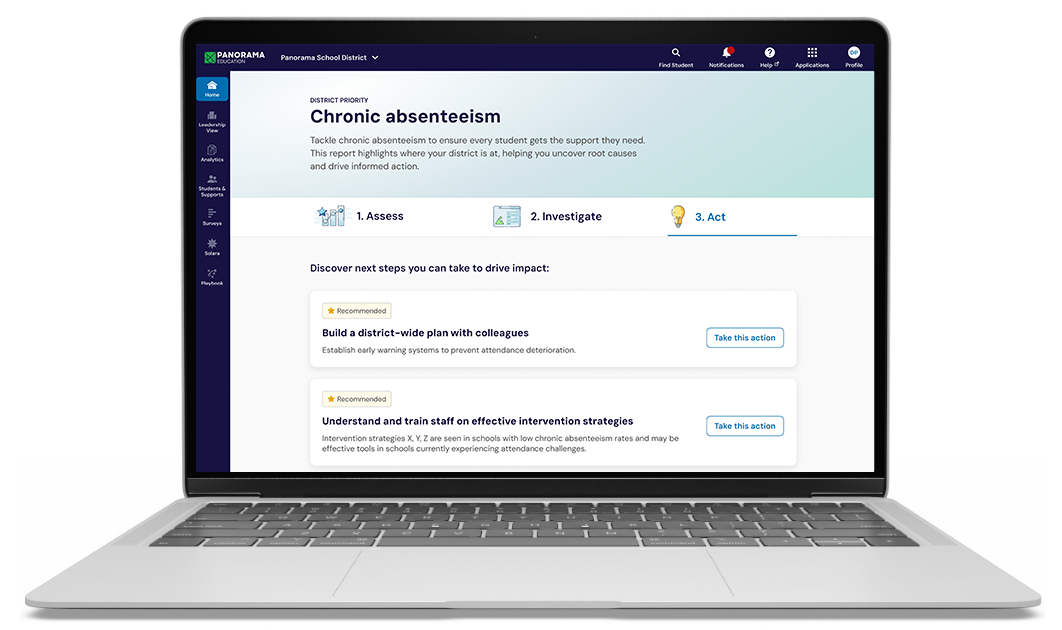When a district brings MTSS to scale, each school’s journey looks a little different. Some teams move quickly into new routines, while others need more time or different tools. Tracking systems may vary, too—leaving leaders without a full view of student support. The challenge isn’t about who’s “ahead” or “behind,” but about aligning practices so every student has access to the same level of care.
So how do you build a cohesive, district-wide MTSS framework while still honoring what makes each school unique? Your schools serve different communities, and your teams have different resources. Districts need more than one-size-fits-all guidance, but also more consistency than if every school designs its own approach.
Districts of all sizes are proving that MTSS can scale. In this blog, we spotlight five unique examples—together representing more than 250,000 students—where leaders have strengthened consistency across schools while still supporting each school’s unique context.
What Is An MTSS Implementation Strategy?
An MTSS implementation strategy is the system by which your district ensures every school can identify and support students in academics, behavior, attendance, and life skills with interventions that adjust to student needs.
This goes beyond data systems and tracking tools. Your implementation strategy outlines the essentials, such as how schools screen students, which evidence-based interventions they'll use, when teams monitor progress, and how they adjust support when students need more help. The best strategies set district-wide expectations while letting schools adapt interventions to their communities.
Without a clear implementation strategy, problems could multiply quickly. Schools may create incompatible systems, meaning that students who switch schools lose support. Teams spend valuable time building processes from scratch, while the school across town has already solved the same problems. Some students might get intensive help, while others with similar needs might be overlooked because they attend different schools.
Districts that successfully scale MTSS find a balance: they set common expectations—like universal screening schedules and progress monitoring cycles—while giving schools the flexibility to select interventions that fit their staff expertise and student needs. This approach ensures every student receives support, while still allowing each school to adapt the framework to its own context.
How Multi-Tiered Support Functions at The District Level
Successful districts make MTSS work through regularly scheduled practices that keep every school aligned.
- It starts with centralized data: The best MTSS platform connects academics, behavior, attendance, and student voice in one dashboard. Intervention teams see which students are chronically absent, struggling in multiple subjects, or showing behavior patterns. Every school accesses the same data through the same system.
- Districts then balance consistency with flexibility: All schools use the same screening tools, data platform, and monitoring schedule. But each school selects interventions that match its resources, where one uses small-group tutoring while another implements peer support programs.
- Making this work starts with intentional training and support: For example, teachers practice running CICO and reading groups. Counselors learn to pull reports and build rosters. Principals study school-wide attendance trends. Training continues as needs change.
- Regular team meetings help bring the framework to life: Teams review data, identify students who need tier changes, and assign staff to interventions. Decisions get documented before the meeting ends.
- Standardized criteria ensure fairness: Every school uses the same benchmarks for tier placement, and every team follows the same protocols—ensuring students get the same consideration regardless of which school they attend.
How District Leaders Are Scaling MTSS Across Every School Site
Every district faces unique challenges, but these five approaches have proven effective for scaling MTSS without compromising on support quality and consistency.
Rockford Public Schools: 27,000 Students, 42 Schools
Building on lessons from earlier MTSS efforts, Rockford introduced a phased rollout. They launched their platform in January 2021, then dedicated February through April to role-specific training. An MTSS Manual and Implementation Rubric provided every school with a clear, consistent playbook. Regular biweekly meetings with Panorama helped sustain teacher engagement, while a unified data system replaced fragmented tracking methods—bringing all 42 schools into a shared approach.
Read Rockford’s story: Creating and Implementing a Remarkable MTSS at Rockford Public Schools
School District U-46: 34,000 Students, 55 Schools
U-46 began with nine pilot schools in its Larkin Network, where reading proficiency increased from 8% to 34% in just two years. The district brought consistency to intervention cycles—which had previously varied from a full semester to just a few weeks—ensuring students received timely and equitable support. Leaders also prioritized professional learning, providing classroom coverage so teachers could complete training during the workday, resulting in full participation. By embedding MTSS practices into existing PLCs, U-46 is now scaling from 7 schools this year to 29 next year.
Read U-46’s story: From PD to Practice: How U-46 is Moving MTSS Forward in Illinois
Campbell-Kapolei and Kailua-Kalaheo Complex Areas: 170,000 students (in HIDOE)
The Campbell-Kapolei and Kailua-Kalaheo Complex Areas (Hawaii) needed a way to streamline intervention tracking and improve collaboration across schools. With Panorama Student Success, educators centralized data, used attendance as a universal screener to identify patterns like Friday absences, and built continuity so students don’t “start over” when they change schools. Shared notes and real-time data updates now give high schools deeper insight into incoming freshmen, ensuring more consistent and proactive support.
Read the Campbell-Kapolei and Kailua-Kalaheo Complex Areas’ story: Bridging the Gaps: How Hawaii Schools are Improving Attendance and Academics through Tiered Supports
Boston Public Schools: 54,000 students 117 Schools
Boston Public Schools, spanning 117 schools, turned to Panorama Solara to bring greater consistency and efficiency to its MTSS framework. With 149 MTSS coordinators balancing multiple roles, the district needed a way to streamline intervention planning and ensure stronger follow-through. Solara now helps educators write SMART goals, align interventions with district resources, and reduce administrative burden. By integrating with Student Success, BPS has strengthened MTSS execution across schools—giving teachers more time to focus on students and helping leaders make more data-informed decisions.
Read Boston Public School’s story: Enhancing MTSS with AI: How Boston Public Schools is Leading the Way with Panorama Solara
Ogden School District: 12,300 Students, 20 Schools
Ogden serves more than 12,000 students, the majority of whom are students of color and qualify for free or reduced-price lunch. Facing high dropout rates and chronic absenteeism, the district centralized data from multiple systems into Panorama Student Success, cutting data prep from days to minutes. Weekly Child Assistance Team (ChAT) meetings now use this integrated view to coordinate supports, with goals of raising the graduation rate to 88% and boosting literacy to 50%. Early results show stronger collaboration, more consistent interventions, and powerful student success stories.
Read Ogden’s story: How Ogden School District is Building and Scaling MTSS
Measuring Success in Districtwide Student Support
Knowing what to implement and making it stick are two different challenges. Districts where MTSS thrives don’t just launch new systems—they sustain them by focusing on a handful of critical practices. These practices require investment, thoughtful decision-making, and steady attention long after the rollout.
1. Academic Indicators: Monitor student progress with consistent benchmarks, such as grade-level reading proficiency, assessment growth, and course completion rates.
2. Engagement Metrics: Track attendance patterns, chronic absenteeism, behavioral referrals, and intervention completion rates to understand how engaged students are in school.
3. System Health Indicators: Aim for a balanced tier distribution (10–15% in Tier 2, ~5% in Tier 3). Review how effectively interventions are implemented and how quickly students are identified.
4. Efficiency Metrics: Look at time spent on data compilation, the percentage of intervention plans completed, and the effectiveness of staff meetings.
5. Progress Monitoring Frequency: Ensure data is reviewed regularly—tracking how often interventions are adjusted, how goals are achieved, and how frequently teams meet to review progress.
Why Panorama Is the Best Solution for Scaling MTSS
Scaling MTSS across a district isn’t easy. It requires consistent frameworks, flexible execution, and systems that make data accessible and actionable. The districts highlighted here show that when leaders invest in the right structures, educators can spend less time chasing down information and more time delivering the supports that help students thrive.
Panorama Student Success brings those elements together in one platform — from real-time dashboards and intervention tracking in Student Success, to AI-powered planning in Solara, to research-based strategies in Playbook. With the right tools and professional learning, districts can move beyond fragmented approaches to create MTSS systems that are both sustainable and student-centered.
Ready to explore what this could look like in your schools?
Watch a product tour to see Panorama in action.



.jpg)
.png)
![3 Strategies for Building Effective Student Support Teams [+ Templates]](https://www.panoramaed.com/hubfs/IMG_3959.jpg)

